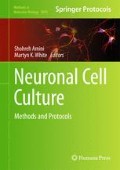Abstract
This chapter describes the culture and propagation of murine embryonic stem cells, F9 and P19 and strategies for differentiation of these stem cells into neurons. Protocols focus on maintenance and propagation of these cells and routine procedures employed for differentiation into neuronal cells. Additional protocols are also described for obtaining enriched populations of mature neurons from P19 cells and differentiation of F9 cells into serotonergic or catecholaminergic neurons.
The protocols described herein can be employed for dissection of the pathways such as gliogenesis and neurogenesis that are involved in differentiation of pluripotent stem cells such as F9 and P19 into glial cells or terminally differentiated neurons.
Access this chapter
Tax calculation will be finalised at checkout
Purchases are for personal use only
References
Martin GR (1980) Teratocarcinomas and mammalian embryogenesis. Science 209: 768–776
Bernstine EG, Hooper ML, Grandchamp S, Ephrussi B (1973) Alkaline phosphatase activity in mouse teratoma. Proc Natl Acad Sci U S A 790:3899–3903
McBurney MW, Rogers BJ (1982) Isolation of male embryonal carcinoma cells and their chromosome replication patterns. Dev Biol 89:503–508
Martin CA, Ziegler LM, Napoli JL (1990) Retinoic acid, dibutyryl-cAMP, and differentiation affect the expression of retinoic acid receptors in F9 cells. Proc Natl Acad Sci U S A 87:4804–4808
Jones-Villeneuve EM, McBurney MW, Rogers KA, Kalnins VI (1982) Retinoic acid induces embryonal carcinoma cells to differentiate into neurons and glial cells. J Cell Biol 94: 253–262
Kuff EL, Fewell JW (1980) Induction of neural-like cells and acetylcholinesterase activity in cultures of F9 teratocarcinoma treated with retinoic acid and dibutyryl cyclic adenosine monophosphate. Dev Biol 77:103–115
Strickland S, Sawey MJ (1980) Studies on the effect of retinoids on the differentiation of teratocarcinoma stem cells in vitro and in vivo. Dev Biol 78:76–85
Liesi P, Rechardt L, Wartiovaara J (1983) Nerve growth factor induces adrenergic neuronal differentiation in F9 teratocarcinoma cells. Nature 306:265–267
Datta PK, Budhiraja S, Reichel RR, Jacob ST (1997) Regulation of ribosomal RNA gene transcription during retinoic acid-induced differentiation of mouse teratocarcinoma cells. Exp Cell Res 231:198–205
St-Arnaud R, Craig J, McBurney MW, Papkoff J (1989) The int-1 proto-oncogene is transcriptionally activated during neuroectodermal differentiation of P19 mouse embryonal carcinoma cells. Oncogene 4:1077–1080
Macpherson PA, Jones S, Pawson PA, Marshall KC, McBurney MW (1997) P19 cells differentiate into glutamatergic and glutamate-responsive neurons in vitro. Neuroscience 80: 487–499
Magnuson DS, Morassutti DJ, McBurney MW, Marshall KC (1995) Neurons derived from P19 embryonal carcinoma cells develop responses to excitatory and inhibitory neurotransmitters. Brain Res Dev Brain Res 90: 141–150
Morassutti DJ, Staines WA, Magnuson DS, Marshall KC, McBurney MW (1994) Murine embryonal carcinoma-derived neurons survive and mature following transplantation into adult rat striatum. Neuroscience 58:753–763
Magnuson DS, Morassutti DJ, Staines WA, McBurney MW, Marshall KC (1995) In vivo electrophysiological maturation of neurons derived from a multipotent precursor (embryonal carcinoma) cell line. Brain Res Dev Brain Res 84:130–141
Hwang CK, Kim CS, Kim do K, Law PY, Wei LN, Loh HH (2010) Up-regulation of the mu-opioid receptor gene is mediated through chromatin remodeling and transcriptional factors in differentiated neuronal cells. Mol Pharmacol 78:58–68
Hwang CK, Song KY, Kim CS, Choi HS, Guo XH, Law PY, Wei LN, Loh HH (2009) Epigenetic programming of mu-opioid receptor gene in mouse brain is regulated by MeCP2 and Brg1 chromatin remodelling factor. J Cell Mol Med 13:3591–3615
Darrow AL, Rickles RJ, Strickland S (1990) Maintenance and use of F9 teratocarcinoma cells. Methods Enzymol 190:110–117
Mouillet-Richard S, Mutel V, Loric S, Tournois C, Launay JM, Kellermann O (2000) Regulation by neurotransmitter receptors of serotonergic or catecholaminergic neuronal cell differentiation. J Biol Chem 275: 9186–9192
Kellermann O, Kelly F (1986) Immortalization of early embryonic cell derivatives after the transfer of the early region of simian virus 40 into F9 teratocarcinoma cells. Differentiation 32:74–81
Buc-Caron MH, Launay JM, Lamblin D, Kellermann O (1990) Serotonin uptake, storage, and synthesis in an immortalized committed cell line derived from mouse teratocarcinoma. Proc Natl Acad Sci U S A 87: 1922–1926
Kellermann O, Loric S, Maroteaux L, Launay JM (1996) Sequential onset of three 5-HT receptors during the 5-hydroxytryptaminergic differentiation of the murine 1C11 cell line. Br J Pharmacol 118:1161–1170
Monzo HJ, Park TI, Montgomery JM, Faull RL, Dragunow M, Curtis MA (2012) A method for generating high-yield enriched neuronal cultures from P19 embryonal carcinoma cells. J Neurosci Methods 204:87–103
Goldstein B, Rogelj S, Siegel S, Farmer SR, Niles RM (1990) Cyclic adenosine monophosphate-mediated induction of F9 teratocarcinoma differentiation in the absence of retinoic acid. J Cell Physiol 143:205–212
Acknowledgments
I am grateful to Dr. Ron Reichel for introducing me to the field of embryonic stem cells and differentiation during the early years of my career. Studies in the author’s laboratory are funded by a grant from NIH/NIDA.
Author information
Authors and Affiliations
Editor information
Editors and Affiliations
Rights and permissions
Copyright information
© 2013 Springer Science+Business Media New York
About this protocol
Cite this protocol
Datta, P.K. (2013). Murine Teratocarcinoma-Derived Neuronal Cultures. In: Amini, S., White, M. (eds) Neuronal Cell Culture. Methods in Molecular Biology, vol 1078. Humana Press, Totowa, NJ. https://doi.org/10.1007/978-1-62703-640-5_4
Download citation
DOI: https://doi.org/10.1007/978-1-62703-640-5_4
Published:
Publisher Name: Humana Press, Totowa, NJ
Print ISBN: 978-1-62703-639-9
Online ISBN: 978-1-62703-640-5
eBook Packages: Springer Protocols

